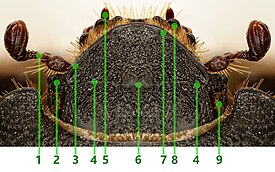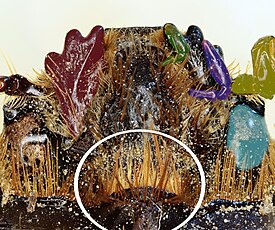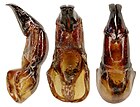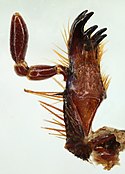Pentodon idiota
| Pentodon idiota | ||||||||||||
|---|---|---|---|---|---|---|---|---|---|---|---|---|

Pentodon idiota |
||||||||||||
| Systematics | ||||||||||||
|
||||||||||||
| Scientific name | ||||||||||||
| Pentodon idiota | ||||||||||||
| ( Autumn , 1789) |
Pentodon idiota (also corn dung beetle ) is a beetle fromthe scarab beetle family and the giant beetle subfamily(Dynastinae). The genus Pentodon has sixteen species worldwide and five species in Europe. The species Pentodon idiota occurs in Europe in two subspecies. Pentodon idiota idiota has a large distribution area in Southeastern Europe, Eastern Southern Europe and the Eastern Palearctic, Pentodon idiota memnon is found in France, Spain and North Africa. Another subspecies Pentodon idiota gumariensis is known from Pakistan .
Comment on the name
The first description of the genus is that of Hope from 1837 . However, this takes the generic name from Kirby . The name is derived from ancient Greek πέντα pénta , five, and οδούς, οδόντος, odōūs, odóntos, tooth, and refers to the unusual structure of the lower jaw, which has five teeth at the tip (Fig. 11). The beetle was first described by Herbst in 1789 and at that time still assigned to the genus Scarabaeus . Herbst does not explain why he chose the species name idiota ( Latin idiōta ignorant, bungler). In Hungary, where the beetle is common, it is called butabogàr ( Hungarian buta for stupid, stupid, bogár for beetle) in the local language . Perhaps the name is a nod to the beetle's awkward way of moving.
In the literature one also finds the name Pentodon monodon after a later description of the species by Fabricius from 1792 as Scarabaeus monodon . The species name monodon refers to the fact that the hump on the forehead is only single-pointed and not double-pointed (gr. Μόνον monon, one and οδούς, οδόντος, odōūs, odóntos, tooth).
The subspecies Pentodon idiota memnon was described by Jakowlew (Jakovlev, Jakowleff) in 1902 as the new species Pentodon memnon . As is often the case, the (sub) species name Memnon was chosen from Greek mythology.
Properties of the beetle
The black-brown to black beetle is fourteen to twenty-two millimeters long. It is plump, about half as wide as it is long and almost as high as it is wide. The top is matt to silk-gloss, the bottom is glossy (Fig. 1).
The head is small. The most important defining features are located on it. The head shield ( clypeus ) is strong and coarse. It narrows towards the front and leaves the three rounded teeth on the outer edge of the upper jaw (Fig. 2 No. 8, Fig. 4 red-purple, Fig. 5) uncovered, but hides the upper lip. At the top, the head shield can be evenly rounded (Fig. 3 left) or it ends flattened with an indicated tooth on each side (Fig. 3 right). Herbst wrongly assigned these two forms of the head shield to the two genders in the first description. However, the absence or presence of teeth gives no indication of gender. Rather, this can be seen at the end of the body (see below). The head shield is bordered on the side (Fig. 2 No. 3), the border flattens out towards the front and can disappear completely. The head shield is demarcated from the forehead by a raised seam, which runs across the head as a clear line in front of the eyes (Fig. 2 No. 4). In the middle, this seam is raised to form a short, transverse and blunt elevation (Fig. 2 No. 6). This can be almost in two parts, but it is not two-humped as in Pentodon bidens and Pentodon quadridens .
The head is wrinkled and roughly punctured . The feelers (Fig. 2 No. 1, Fig. 4 right yellow, Fig. 8) are deflected under a bend of the cheeks (Fig. 2 No. 2). They are ten- limbed (not eleven-limbed like the dung beetles ) and end in a three-leaved egg-shaped club. The antennae are shiny and sparsely hairy. The ark of the lower jaw has five strong and pointed teeth at the top (Fig. 11). The jaw probes (Fig. 11 left, Fig. 2 No. 5, Fig. 4 right purple) end in a long spindle-shaped link. The three-part lip buttons (Fig. 4 right, green) are pivoted on the side of the lower lip. The two base links are short, the end link is elongated and slightly thickened towards the base.
The pronounced pronotum is slightly wider than it is long. Its greatest width is behind the center. The pronotum is moderately dense but roughly punctured . It is bordered on the sides and in front, the border becomes narrower towards the rear. The base is unrimmed.
The label is large and triangular, about the same width as it is long.
The elytra are dotted with dots of two different sizes (Fig. 13). The smaller points are arranged irregularly, the arrangement of the larger points in point stripes is more or less clearly defined. In the typical case, the large dots form three double rows that do not run parallel to the wing cover seam , but rather approach it towards the rear (clearly visible in the taxo image, also in Fig. 1 center when enlarged). Another point strip runs right next to the seam.
Six abdominal segments are visible on the abdomen (Fig. 1, blue on the right), the respiratory openings ( stigmata ) are located in the sclerotized sternites (Fig. 12). The front edge of the front chest is strongly arched like a bump in the middle and there is hairy and hairy protruding (Fig. 4 circled in white).
The legs are short and strong. The tarsi are all five-part. They are relatively slender, only the 1st link widened triangularly towards the tip (Fig. 10 and Fig. 9 blue 1). The claws are small. The claw link bears an onychium ( dewclaw , green arrowhead Fig. 10). The front legs are designed as grave legs . The thighs of the front legs are dotted and hairy on the front. The front rails have three wide teeth on the outside (Fig. 6 arrowheads). In between there are usually several other teeth (serrated teeth) that improve digging ability. The rails of the middle and rear pair of legs are widened at the top. On the outside they have two sloping, slightly raised ridges that are covered with a row of teeth (Fig. 9, green arrowheads). A third ring gear runs along the rear edge of the rails. The splints of the middle and rear pair of legs end with two flattened terminal spines that are brought closer together (Fig. 9, black arrows).
The end of the abdomen in the female tends to run flat backwards and ends in an ogival shape, while in the male it is more arched and more rounded. The aedeagus is shown in Figure 7. It differs from the Aedeagi of the other European species in that the gap between the paramers is almost diamond-shaped when viewed from above and the slender tips of the paramers are rounded off.
Larvae
The larvae belong to the grubs type . The grubs of the giant beetles are characterized by the fact that the two chewings of the maxillae ( lacinia and galea ) are fused together, and that on the dorsal inner edge of the maxillary segment in front of it ( stipes ) there is a row of stridulation teeth that are as wide as they are long and not are curved and pointed.
biology
The beetles are tightly bound to warm, sandy and dry locations. They live on open land (formerly steppe). They also tolerate salty soils. They appear from April to September. The crepuscular and nocturnal animals are lazy during the day and try to hide in the grass or under stones. They can fly and swarm at night. They mainly feed on dead plant remains, but they can also gnaw and damage weakened plants such as seedlings.
The females usually lay the eggs in the ground in early summer. The development takes several years, in southern Russia the life cycle is three years, the species overwinters twice as a larva, then pupates at the end of summer and the newly hatched adults overwinter again. They swarm in late spring and early summer. In Iran, larval development takes fifteen to twenty months. Adults and various larval stages overwinter.
The larvae live in the ground and feed on both dead roots and the roots of still living plants. That is why they are often listed as pests. They are particularly harmful on maize , which is also called maize dung beetle in Russian (Кукурузный навозник). However, beetles or larvae damage numerous other crops. For example, damage to maize, grapevines , sugar beet , onions , garlic , sunflowers and watermelons was reported from Russia in 1914 , all of which was attributed to Pentodon idiota . Damage to the Asian wild apple was also reported from Russia in 2019 . The beetle causes losses of up to 90 percent of sugar cane in some areas. In a Russian atlas on pest control, feeding damage to apple, pear, apricot, cherry plum , mulberry, oak and various berry bushes is also mentioned. The species was reported as a pest on pistachios from Iran .
Both males and females can make sounds through stridulation . For this purpose, a field of small biconvex transverse grooves are formed on both sides of the penultimate spinal shield ( propygidium ) near the wing cover seam (Fig. 14), on which the rear part of the wing covers is rubbed. The result is a sound that is reminiscent of a ratchet . In YouTube there is a video documenting the movements of the abdomen and the resulting noise.
distribution
The occurrence of the species suggests that the original range was larger and that the beetle is now restricted to remnants of this area as a steppe relic. The two subspecies are spatially clearly separated. Pentodon idiota memnon is found in southern France , Spain and North Africa . The western border of the distribution area of Pentodon idiota idiota runs through the Czech Republic , Austria , Hungary , Croatia , Herzegovina , Albania and Greece . The distribution area continues to Asia Minor and Asia via the eastern European states. There the species is known from Iran , Iraq , Israel , Lebanon , Turkey and Xinjiang .
literature
- Heinz joy , Karl Wilhelm Harde , Gustav Adolf Lohse (ed.): The beetles of Central Europe . tape 8 . Teredilia Heteromera Lamellicornia . Elsevier, Spektrum, Akademischer Verlag, Munich 1969, ISBN 3-8274-0682-X . P. 357
- Klaus Koch : The Beetles of Central Europe Ecology . 1st edition. tape 2 . Goecke & Evers, Krefeld 1989, ISBN 3-87263-040-7 . P. 377
- Edmund Reitter : Fauna Germanica, the beetles of the German Empire, Volume II, KGLutz 'Verlag, Stuttgart 1909 p. 340
- Gustav Jäger (Ed.): CG Calwer's Käferbuch. K. Thienemanns, Stuttgart 1876, 3rd edition p. 270
Individual evidence
- ↑ a b Pentodon idiota , P. idiota idiota and P. idiota memnon from Fauna Europaea, accessed on Dec. 18, 2019
- ↑ Catalog of Life, accessed on January 6, 2020 P. i. gumariensis
- ^ FW Hope: The coleopterist's manual London 1837 p. 92 Pentodon
- ↑ Sigmund Schenkling: Explanation of the scientific beetle names (genus)
- ↑ a b Sigmund Schenkling: Explanation of the scientific beetle names (species)
- ↑ a b Jablonsky, Herbst: Natural system of all domestic and foreign insects, the Käfer zweyter Theil Berlin 1789, page 250: 164
- ↑ Vernicularname at Catalogaue of Life and Hungarian Wikipedia w: hu: Butabogár
- ↑ Joh. Chr. Fabricius: Entomologiae systematicae, emmendatae et auctae Volume 1, Hafnia (Copenhagen) 1792 p. 20 57. Art from Scarabaeus, Monodon
- ↑ BE Jakowleff: Huit nouvelles espèces de genre pentodon Hope (Coleoptera, Scarabaeidae) in ТРУДЫ РУССКАГО ЭНТОМОЛГИЧЕТСКАГО ОБЩЕСТВА - Horae Societatis entomologicae Rossicae . 35. Volume No. 3 - 4, St. Petersburg 1902, p 266ff S. 271 memnon pentodon
- ^ E. Mulsant: Observations sur le Pentodon monodon in Opuscules entomologiques 1st issue, Paris 1852, p. 11 ff p. 12 Sex differences
- ↑ Jacques Baraud: Faune de France, Coléoptères Scarabaeoidea d'Europe Paris 1992, p. 759 illustrations of the parameters of the European species of the genus Pentodon
- ↑ pentodon at coleonet
- ↑ E. Reitter: Overview of the species related to Pentodon idiota Herbst, with a single frontal cusp in German Entomological Journal 1894 London, Berlin, Paris p. 44 identification key
- ↑ HC Küster: The Beetles of Europe - described from nature 10. Issue Nuremberg 1847 p. 115 as Pentodon monodon
- ^ Adam G. Böving, EC Craighead: Larvae of coleoptera New York 1931 key p. 51
- ↑ Young-Chul Jang: Description of Larva and Pupa of Pentodon quadridens bidentulus (Fairmaire, 1887) (Coleoptera, Scarabaeidae, Dynastinae) and Notes on Its Biology Larva and Pupa of Pentodon quadridens bidentulus 2019 Fig. 3 right SD: Row of stridulation teeth at Pentodon quadridens
- ↑ Джамалутдинова Т.М., Магомедов Г.А., Алиев М.А .: К ИЗУЧЕНИЮ ЭКОЛОГИИ И ФАУНЫ ПЛАСТИНЧАТОУСЫХ ЖУКОВ (COLEOPTERA, Scarabaeidae) ХАСАВЮРТОВСКОГО РАЙОНА РЕСПУБЛИКИ ДАГЕСТАН (studies on ecology and fauna of scarab beetles in the district of Khasavyurt of the Republic of Dagestan) in the commemorative publication of the Ministry of Education and Science on the 75th BIRTHDAY OF PROFESSOR SHEYIKH IBRAGIMOVICH ISMAILOV, "EDUCATIONAL UNIVERSITY OF THE STATE OF DAGESTAN" Makhachkala March 2016 ISBN 978-5-4242-0431-9 Pentodon idiota p. 24
- ↑ И. В. Шохин, В. Ю. Бозаджиев: Пластинчатоусые жуки (Coleoptera: Scarabaeoidea) Ростовской области (scarab beetles on the grate over area) in Элекронный журиал ИССЛЕДОВАНО в РОССИИ S. 486 or 19/21 pentodon idiota
- ↑ Jemsi Nobandegani, Hassani Zadeh, Farham, A .: Investigations on Pentodon idiota Herbst in Khoozestan in Entomologie et Phytopathologie Appliquées (Iran) 1988, summary in Agri's summary
- ↑ a b P. P. Savkovsky: Atlas of the pests of fruits and berries Russian, 5. Auflage.K. Harvest, 1990 Russian text to pentodon idiota
- ↑ Review of applied entomology Vol. III, Series 1 Agricultural, London 1915, also contains a compilation of various Russian lists of agricultural damage reports from 1914, p. 47: Corn, watermelon, sunflower , p. 544 onion and garlic , p. 542 Zuckerrübe , p. 222 larva on grapevine roots
- ↑ R. Jashenko, G. Tanabekova: Insects did damage the wild populations of Malus sieversii in Kazakhstan in IOP Conf. Series: Earth and Environmental Science 298 (2019) 012018, doi: 10.1088 / 1755-1315 / 298/1/012018 to Malus sieversii
- ^ W. Gentry: Crop-insects of Northeast Afrika - Southwest Asia Agriculture handbook No 273, Agricultural Research Service, United States Department of Agriculture, Washington 1965 Pentodon idiota in the Google book search
- ↑ E. Adeli: Contribution to the knowledge of insects harmful to the forest in Iran in Journal of applied entomologie Vol 70, Issue 1 - 4, 1972, summary in Wiley summary
- ^ BE Jakowlew: Note on the stridulation apparatus in the species of the genus Pentodon Hope , summary in German by K. Daniel in Münchner Koleopterologische Zeitschrift 1st volume, 2nd delivery, Munich 1903 p. 144 No. 132 Stridulationsorgan
- ↑ Video with stridulation on YouTube
- ↑ BE Jakowleff: Comments on the species of the genus Pentodon (Russian), summarized in German in the Münchner Koleopterologische Zeitschrift II. Volume, 2, Liefer München 1904 p. 143, no. 229
- ^ Herbert Franz: Steppe relicts in Southeast Central Europe and their history in VII. International Congress for Entomology Negotiations Volume 1 Weimar April 1939 p. 112 on salty soils
- ↑ López-Colon JI, Löbl I. & Nikolajev GV: Catalog of Palaearctic Coleoptera, Vol. 3, Scarabaeoidea, Scirtoidea, Dascilloidea, Buprestoidea and Byrrhoidea Apollo Books, Stenstrup 2006















